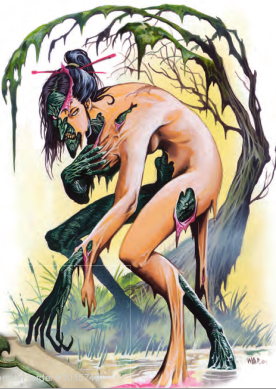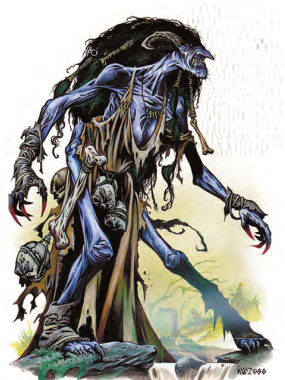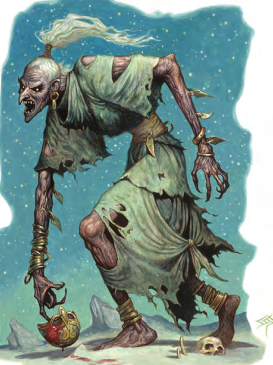Let's Read the 4e Monster Manual/Vault: Hag
This article is part of a series! Click here to see the other entries.
Hags have been in the game since the days of AD&D at least. Here they are present in both books.
The Lore
Hags are fairytale witches. It seems that the more traditional types of D&D hags were each inspired by a specific tale (Black Annis, Jenny Greenteeth and so on), but even the new ones all share in that same aesthetic.
The original fairy tales aren’t always clear on whether their witches are human or not, but in D&D they explicitly not human. Hags are a type of fey that happen to resemble horrible women. They’re thematically linked to nature’s ugliness, in much the same way dryads are linked to its beauty.
As befits fairytale witches, hags live in places inhospitable to humans such as haunted forests, dismal swamps or lonely mountain-tops castigated by storms. Their use magic to build lairs fitting their particular sense of aesthetics: huts that walk on chicken feet, giant trees shaped like crucified corpses, and probably the occasional gingerbread house located where a lost child might stumble upon it.
While I suppose you might find an Unaligned hag that just wants to be left alone, the books present them as typically Evil. They’re greedy, selfish, and dislike beautiful things. These hags usually have one or more sinister schemes going on, which they advance through social manipulation and the use of magic. Their end goals might be a simple as accumulating more treasure, or as esoteric as weakening the metaphysical concept of beauty in the world. Or maybe it’s something in between like exacting revenge on a mortal family for a centuries-old slight.
All hags see each other as sisters and keep in touch, though mostly to bicker and argue. It’s likely at least some of a hag’s schemes are aimed at her own “family” instead of at unsuspecting mortals.
As far as evil D&D monsters go, hags are surprisingly amenable to parley. They’ll gladly negotiate with PCs and even give gifts if that would advance their long-term plans. The MV mentions more heroes were ultimately defeated by a hag’s kindness than by their claws.
The Numbers
There’s quite a bit of variation between different hag stat blocks, but they do share some common themes and abilities. They’re all Medium Fey Humanoids, and each one is trained in several skills: Bluff is universal, as is either Nature or Arcana. Stealth and Insight are very common as well.
In 4e effects not directly relevant to combat tend to stay out of a monster’s stat block, so even though every hag is a powerful spellcaster with knowledge of rituals long lost to mortals, in combat they mostly rely on their superhuman strength, claws, and perhaps one or two magical abilities.
One such ability all hags have is Change Shape. This usually allows them to take the form of a woman of any humanoid race, and lasts until the hag uses the ability again or dies. Some of them have additional restrictions on what forms they can take, but in the end they can always appear as civilians to mortal eyes.
Like doppelgangers, hags might disguise themselves as specific individuals they’ve observed, in which case spotting the disguise requires beating them in an opposed Insight vs. Bluff check where the hag has a +20 bonus. The MV versions instead give fixed DCs which are a bit more forgiving, but still quite hard.
Howling Hag (MM)
This Level 7 Controller has 83 HP, low-light vision, and a lot of sound-based powers. It moves at Speed 6, has Resist 10 Thunder, and constantly mutters a series of Baleful Whispers (Aura 5) which cause a bit of psychic damage to anyone in range.
The howling hag fights with a quarterstaff in melee, and attacks at range with a Howl (Close Blast 5 vs. Fortitude) for thunder damage. It can intensify that into a Shriek of Pain that does more damage, and recharges when the hag is bloodied. The second, bloodied shriek will do even more damage.
For support skills, it can Change Shape as above to assume the form of an old crone of any Medium humanoid species. It can also use a Fey Step once per encounter to teleport up to 10 squares.
Unfortunately, this hag’s damage is all over the place. The staff and basic howl attacks suffer from “naturalistic” design and are most in need of repair. The Shriek is closer to appropriate but still needs a tiny boost.
Bog Hag (Both)

Bog Hags are Level 10 Skirmishers with 107 HP, low-light vision and Speed 8 on both land and water. They’re Aquatic and have Swamp-Walk, ignoring swamp-based difficult terrain. Their Unwholesome Presence (Aura 3) causes enemies in range to only recover half the usual HP from spending healing surges.
The MV version is the best one. Its basic attack is a Claw that does damage and allows the hag to shift 2 squares as an effect. It also has a Rending Claws special attack, which allows it to use Claw twice (including the shift) and to do 5 extra damage if both attacks hit the same target. This recharges once the hag is first bloodied.
When the hag charges, its Evasive Charge ability allows it to shift 2 squares immediately after the charge.
The MM version is the same, but its damage suffers from the early math flaw and it doesn’t have a shift effect on its basic attack.
In both versions, the hag can Change Shape into a young human, elf or eladrin woman.
Green Hag (MV)
Green Hags have a more classically witchy stat block than the previous two. They’re Level 12 Controllers with 124 HP, and all the same senses and movement modes as the Bog Hag plus Forest Walk. All of their attacks are earth- or plant-themed spells.
Their basic melee attack is Hurl Through the Earth, which does damage and teleports the target 3 squares.
Their at-will ranged attack is Grasping Roots (Area Burst 2 Within 5 vs. Reflex) which does no damage but restrains on a hit (save ends). On a miss, the targets are slowed for a turn instead.
Once per encounter they can use Rampant Growth (Area Burst 2 Within 5 vs. Reflex), which must be centered on someone restrained by Grasping Roots. This does damage and creates a zone that lasts the whole encounter, which counts as damaging difficult terrain for anyone without forest walk.
Slightly more often it can cast Stagnant Miasma (Area Burst 2 Within 5 vs. Fortitude; recharge 5-6), which does poison damage and creates a damaging poison zone that lasts a turn.
The green hag’s Change Shape power allows it to assume the form of a young woman or a crone of any Medium humanoid race.
Night Hag (Both)

Terrifying haunters of dreams, Night Hags are Level 14 Lurkers with 109 HP and Speed 8. They have darkvision, and surround themselves in a Shroud of Night that makes all illumination one step darker in its area of effect: bright light becomes dim, dim light becomes darkness. This is an Aura 5 in the MM, 10 in the MV.
Their basic claw attack also stuns the target (save ends) if the hag has combat advantage. They can also cast a Wave of Sleep (Close Blast 5 vs. Will) that does psychic damage and dazes (save ends). This worsens to unconsciousness (save ends) after the first failed save.
Once the hag has a target stunned or unconscious, it can use its supreme technique: Dream Haunting (Melee 1 vs. Will). This does an initial chunk of psychic damage on a hit, and allows the hag to enter the target’s dreams. It vanishes from play and begins dealing psychic damage to the target automatically on its turn. The hag stays there until the target is no longer stunned or unconscious, or until it dies! Once either of these happens, the hag reappears on an adjacent square, insubstantial for a turn.
This is the combat version of the power. You can of course still have adventures where a night hag sneaks into the PC’s dreams in a more subtle manner.
Night Hags can Change Shape to appear as old crones of any Medium humanoid species.
Death Hag (MM)

Here’s your basic Baba Yaga wannabe. Death hags are Level 18 Soldiers with 171 HP, Speed 6, low-light vision and Resist 10 Necrotic.
Monstrously strong, they attack with claws that mark and prevent any healing from working on the target for a turn. They can also employ life-draining blasts (Close Blast 3 vs. Fortitude; recharge 3-6) that deal necrotic damage and heal the hag for 5 HP for every target hit. Their Change Shape is the most flexible variety detailed at the start of the article.
Sample Encounters and Final Impressions
We have two of those in the Monster Manual:
-
Level 9: 2 howling hags, 2 gnoll demonic scourges and 2 barlguras. These hags are up to even nastier tricks than usual.
-
Level 10: 1 bog hag, 1 venom-eye basilisk, 2 shambling mounds, 2 trolls. And this one has quite the entourage.
I like the concept fairytale witches that you can talk to and (cautiously!) deal with. I’m a bit more inclined than the books to make hags Unaligned, though. Like, they’re deeply into their own business and will definitely curse you or kill you if you’re an ass to them, but if you’re courteous and respectful they’ll give you genuine help. So a bit more like a Russian fairytale than a German one.
Mechanically they end up being a bit simpler and quite a bit more physical than they used to be in previous editions. This is not necessarily a bad thing if it means you no longer have to memorize the effects and frequencies of 14 spell-like abilities. As I said above, ritual casting accounts for most of a hag’s magic now - they certainly have the skills for it.